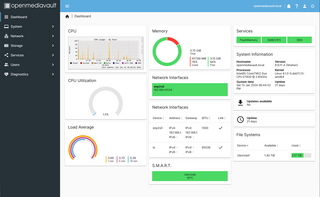
Internet Protocol version 6 (IPv6) is the most recent version of the Internet Protocol (IP), the communications protocol that provides an identification and location system for computers on networks and routes traffic across the Internet. IPv6 was developed by the Internet Engineering Task Force (IETF) to deal with the long-anticipated problem of IPv4 address exhaustion, and was intended to replace IPv4. In December 1998, IPv6 became a Draft Standard for the IETF, which subsequently ratified it as an Internet Standard on 14 July 2017.
Virtual private network (VPN) is a network architecture for virtually extending a private network across one or multiple other networks which are either untrusted or need to be isolated.
SOCKS is an Internet protocol that exchanges network packets between a client and server through a proxy server. SOCKS5 optionally provides authentication so only authorized users may access a server. Practically, a SOCKS server proxies TCP connections to an arbitrary IP address, and provides a means for UDP packets to be forwarded. A SOCKS server accepts incoming client connection on TCP port 1080, as defined in RFC 1928.
OpenVPN is a virtual private network (VPN) system that implements techniques to create secure point-to-point or site-to-site connections in routed or bridged configurations and remote access facilities. It implements both client and server applications.
In computer networking, Teredo is a Microsoft transition technology that gives full IPv6 connectivity for IPv6-capable hosts that are on the IPv4 Internet but have no native connection to an IPv6 network. Unlike similar protocols such as 6to4, it can perform its function even from behind network address translation (NAT) devices such as home routers.
In computer networks, a tunneling protocol is a communication protocol which allows for the movement of data from one network to another. It can, for example, allow private network communications to be sent across a public network, or for one network protocol to be carried over an incompatible network, through a process called encapsulation.
anoNet is a decentralized friend-to-friend network built using VPNs and software BGP routers. anoNet works by making it difficult to learn the identities of others on the network allowing them to anonymously host IPv4 and IPv6 services. One of the primary goals of anoNet is to protect its participants' rights of speech and expression.
Vyatta is a software-based virtual router, virtual firewall and VPN product for Internet Protocol networks. A free download of Vyatta has been available since March 2006. The system is a specialized Debian-based Linux distribution with networking applications such as Quagga, OpenVPN, and many others. A standardized management console, similar to Juniper JUNOS or Cisco IOS, in addition to a web-based GUI and traditional Linux system commands, provides configuration of the system and applications. In recent versions of Vyatta, web-based management interface is supplied only in the subscription edition. However, all functionality is available through KVM, serial console or SSH/telnet protocols. The software runs on standard x86-64 servers.
An IPv6 transition mechanism is a technology that facilitates the transitioning of the Internet from the Internet Protocol version 4 (IPv4) infrastructure in use since 1983 to the successor addressing and routing system of Internet Protocol Version 6 (IPv6). As IPv4 and IPv6 networks are not directly interoperable, transition technologies are designed to permit hosts on either network type to communicate with any other host.

Fail2Ban is an intrusion prevention software framework. Written in the Python programming language, it is designed to prevent brute-force attacks. It is able to run on POSIX systems that have an interface to a packet-control system or firewall installed locally, such as iptables or TCP Wrapper.

Locator/ID Separation Protocol (LISP) is a "map-and-encapsulate" protocol which is developed by the Internet Engineering Task Force LISP Working Group. The basic idea behind the separation is that the Internet architecture combines two functions, routing locators and identifiers in one number space: the IP address. LISP supports the separation of the IPv4 and IPv6 address space following a network-based map-and-encapsulate scheme. In LISP, both identifiers and locators can be IP addresses or arbitrary elements like a set of GPS coordinates or a MAC address.
DirectAccess, also known as Unified Remote Access, is a VPN technology that provides intranet connectivity to client computers when they are connected to the Internet. Unlike many traditional VPN connections, which must be initiated and terminated by explicit user action, DirectAccess connections are designed to connect automatically as soon as the computer connects to the Internet. DirectAccess was introduced in Windows Server 2008 R2, providing this service to Windows 7 and Windows 8 "Enterprise" edition clients. In 2010, Microsoft Forefront Unified Access Gateway (UAG) was released, which simplifies the deployment of DirectAccess for Windows 2008 R2, and includes additional components that make it easier to integrate without the need to deploy IPv6 on the network, and with a dedicated user interface for the configuration and monitoring. Some requirements and limitations that were part of the design of DirectAccess with Windows Server 2008 R2 and UAG have been changed. While DirectAccess is based on Microsoft technology, third-party solutions exist for accessing internal UNIX and Linux servers through DirectAccess. With Windows Server 2012, DirectAccess is fully integrated into the operating system, providing a user interface to configure and native IPv6 and IPv4 support.
dn42 is a decentralized peer-to-peer network built using VPNs and software/hardware BGP routers.

OpenMediaVault (OMV) is a free Linux distribution designed for network-attached storage (NAS). The project's lead developer is Volker Theile, who instituted it in 2009. OMV is based on the Debian operating system, and is licensed through the GNU General Public License v3.
Google Compute Engine (GCE) is the infrastructure as a service (IaaS) component of Google Cloud Platform which is built on the global infrastructure that runs Google's search engine, Gmail, YouTube and other services. Google Compute Engine enables users to launch virtual machines (VMs) on demand. VMs can be launched from the standard images or custom images created by users. Google Compute Engine can be accessed via the Developer Console, RESTful API or command-line interface (CLI).

Endian Firewall is an open-source router, firewall and gateway security Linux distribution developed by the South Tyrolean company Endian. The product is available as either free software, commercial software with guaranteed support services, or as a hardware appliance.
firewalld is a firewall management tool for Linux operating systems. It provides firewall features by acting as a front-end for the Linux kernel's netfilter framework. firewalld's current default backend is nftables. Prior to v0.6.0, iptables was the default backend. Through its abstractions, firewalld acts as an alternative to nft and iptables command line programs. The name firewalld adheres to the Unix convention of naming system daemons by appending the letter "d".
Network Performance Monitor (NPM) in Operations Management Suite, a component of Microsoft Azure, monitors network performance between office sites, data centers, clouds and applications in near real-time. It helps a network administrator locate and troubleshoot bottlenecks like network delay, data loss and availability of any network link across on-premises networks, Microsoft Azure VNets, Amazon Web Services VPCs, hybrid networks, VPNs or even public internet links.
WireGuard is a communication protocol and free and open-source software that implements encrypted virtual private networks (VPNs). It aims to be lighter and better performing than IPsec and OpenVPN, two common tunneling protocols. The WireGuard protocol passes traffic over UDP.
1.1.1.1 is a free Domain Name System (DNS) service by the American company Cloudflare in partnership with APNIC. The service functions as a recursive name server, providing domain name resolution for any host on the Internet. The service was announced on April 1, 2018. On November 11, 2018, Cloudflare announced a mobile application of their 1.1.1.1 service for Android and iOS. On September 25, 2019, Cloudflare released WARP, an upgraded version of their original 1.1.1.1 mobile application.





